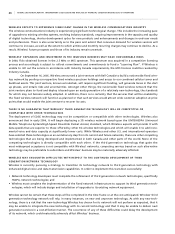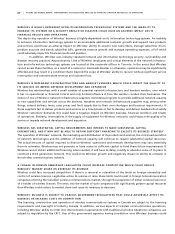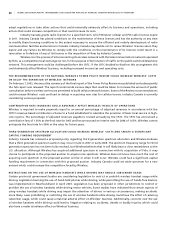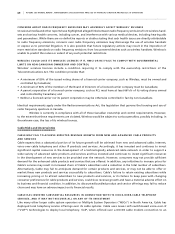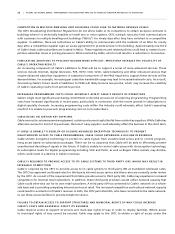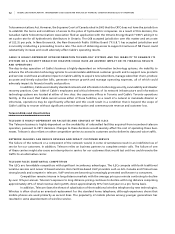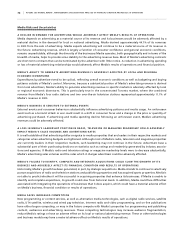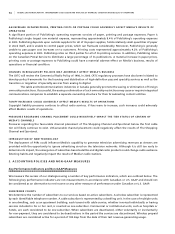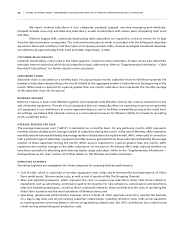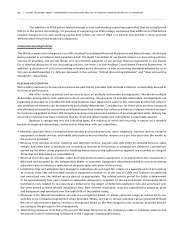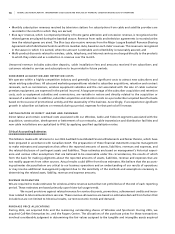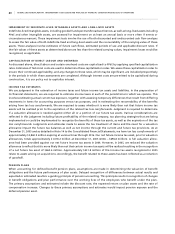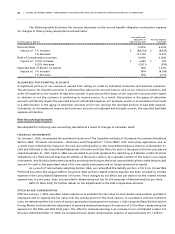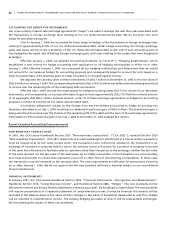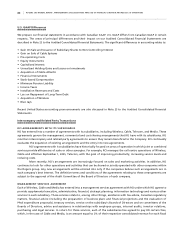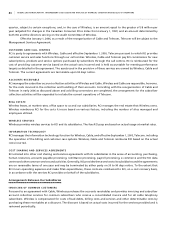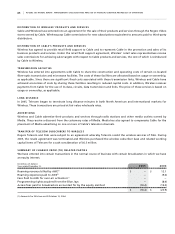Rogers 2005 Annual Report Download - page 79
Download and view the complete annual report
Please find page 79 of the 2005 Rogers annual report below. You can navigate through the pages in the report by either clicking on the pages listed below, or by using the keyword search tool below to find specific information within the annual report.
75 ROGERS 2005 ANNUAL REPORT . MANAGEMENT’S DISCUSSION AND ANALYSIS OF FINANCIAL CONDITION AND RESULTS OF OPERATIONS
We report wireless subscribers in four categories: postpaid, prepaid, one-way messaging and wholesale.
Postpaid includes voice-only and data-only subscribers, as well as subscribers with service plans integrating both voice
and data.
Effective August 2005, voluntarily deactivating cable subscribers are required to continue service for 30 days
from the date termination is requested. This continued service period, which is consistent with the billing and subscriber
agreement terms and conditions, had the impact of increasing net basic cable, Internet and digital household subscriber
net additions by approximately 9,500, 5,200 and 3,800, respectively, in 2005.
CU S T OM E R R EL A T IO N SH I PS
Customer relationships, a term used in the Cable segment, is based on active subscribers to basic service plus subscribers
who take Internet service but which do not subscribe to basic cable service. Refer to “Supplementary Information – Cable
Non-GAAP Calculations” for further details on this calculation.
SU B S CR I BE R C H U RN
Subscriber churn is calculated on a monthly basis. For any particular month, subscriber churn for Wireless represents the
number of subscribers deactivating in the month divided by the aggregate number of subscribers at the beginning of the
month. When used or reported for a period greater than one month, subscriber churn represents the monthly average
of the subscriber churn for the period.
NE T W OR K R E VE N U E
Network revenue is used in the Wireless segment and represents total Wireless revenue less revenue received from the
sale of handset equipment. The sale of such equipment does not materially affect our operating income as we generally
sell equipment to our distributors at a price approximating our cost to facilitate competitive pricing at the retail level.
Accordingly, we believe that network revenue is a more relevant measure for Wireless’ ability to increase its operating
profit, as defined below.
AV E R AG E R E VE N U E P ER US E R
The average revenue per user (“ARPU”) is calculated on a monthly basis. For any particular month, ARPU represents
monthly revenue divided by the average number of subscribers during the month. In the case of Wireless, ARPU represents
monthly network revenue divided by the average number of subscribers during the month. ARPU, when used in connection
with a particular type of subscriber, represents monthly revenue generated from those subscribers divided by the average
number of those subscribers during the month. When used or reported for a period greater than one month, ARPU
represents the monthly average of the ARPU calculations for the period. We believe ARPU helps indicate whether we
have been successful in attracting and retaining higher usage subscribers. Refer to the “Supplementary Information –
Average Revenue Per User” section for further details on this Wireless and Cable calculation.
OP E R AT I NG EX P E NS E S
Operating expenses are segregated into three categories for assessing business performance:
• Cost of sales, which is comprised of wireless equipment costs, Video stores merchandise and depreciation of Video
Store rental assets, Telecom carrier costs, as well as cost of goods sold by The Shopping Channel;
• Sales and marketing expenses, which represent the costs to acquire new subscribers (other than those related to
equipment), such as advertising, commissions paid to third parties for new activations, remuneration and benefits to
sales and marketing employees, as well as direct overheads related to these activities and the costs of operating the
Video Store locations and the retail operations of Wireless stores; and
• Operating, general and administrative expenses, which include all other expenses incurred to operate the business
on a day-to-day basis and service existing subscriber relationships, including retention costs, inter-carrier payments
to roaming partners and long distance carriers, programming related costs, the CRTC contribution levy, Internet and
e-mail services and printing and production costs.



